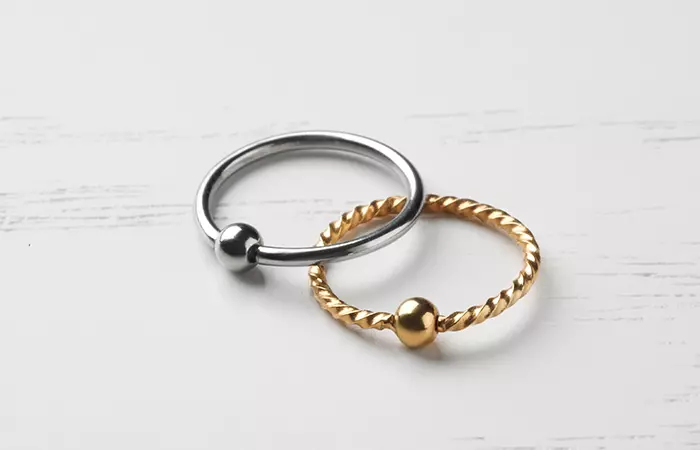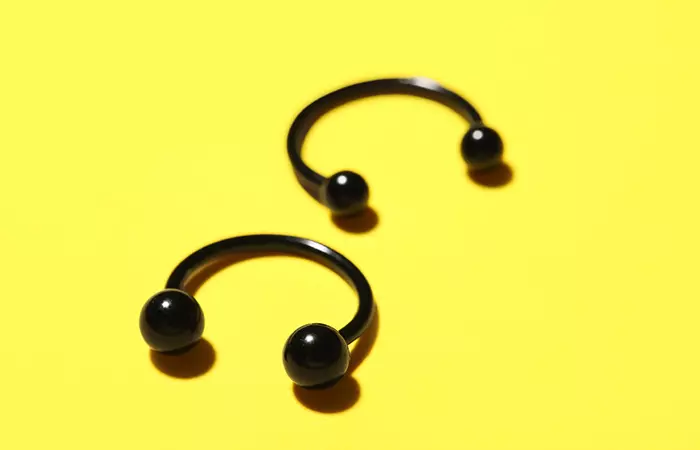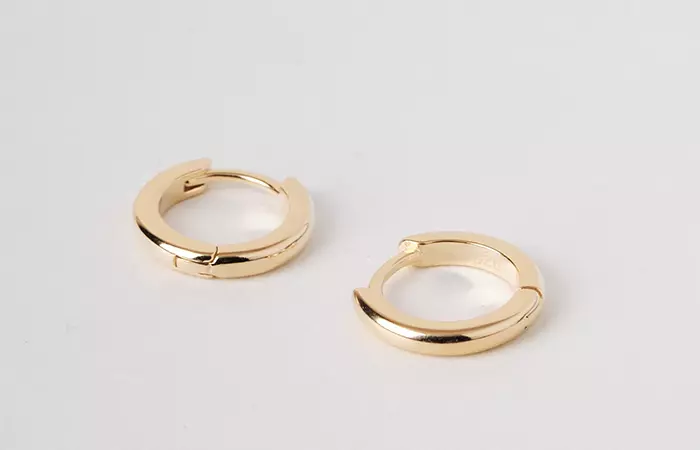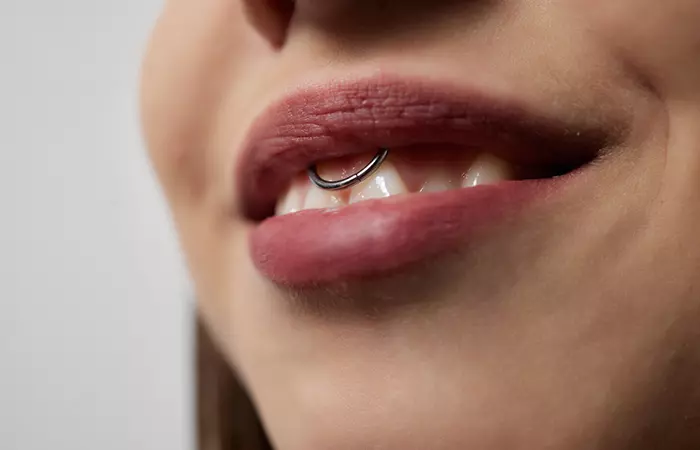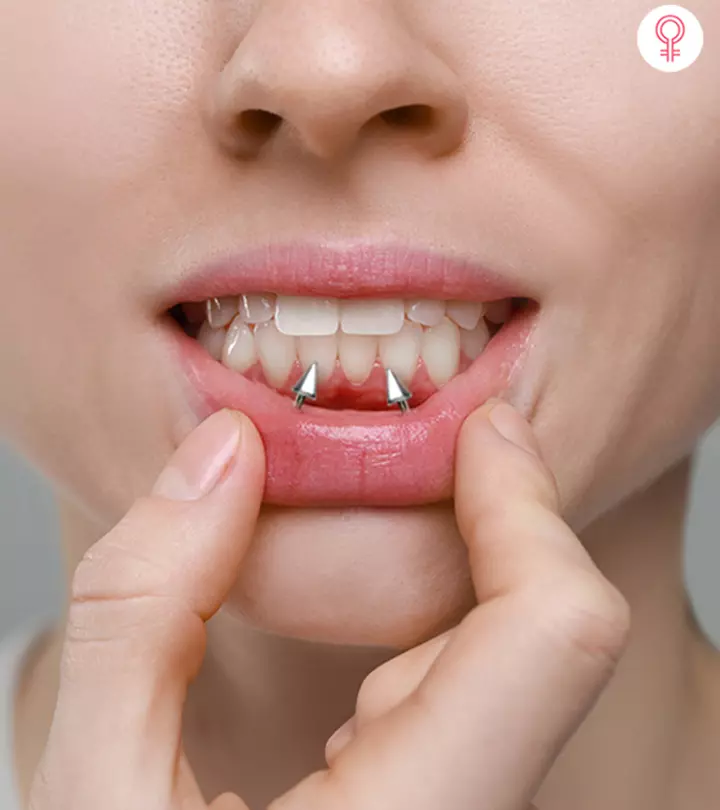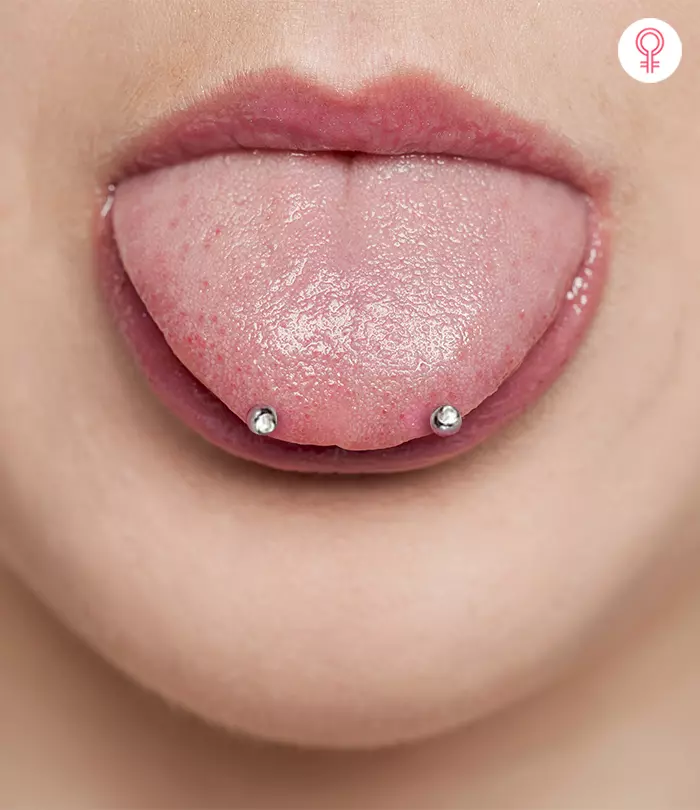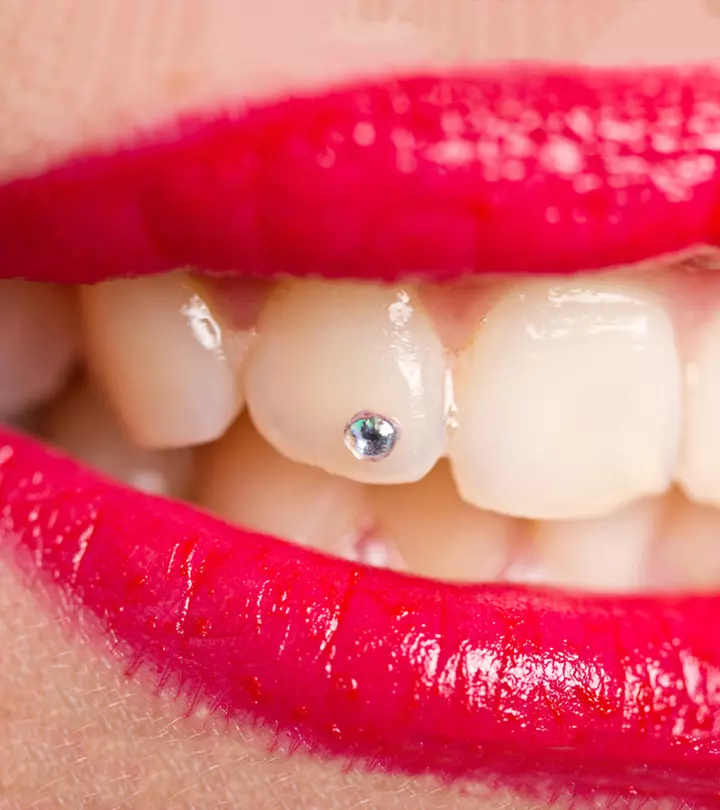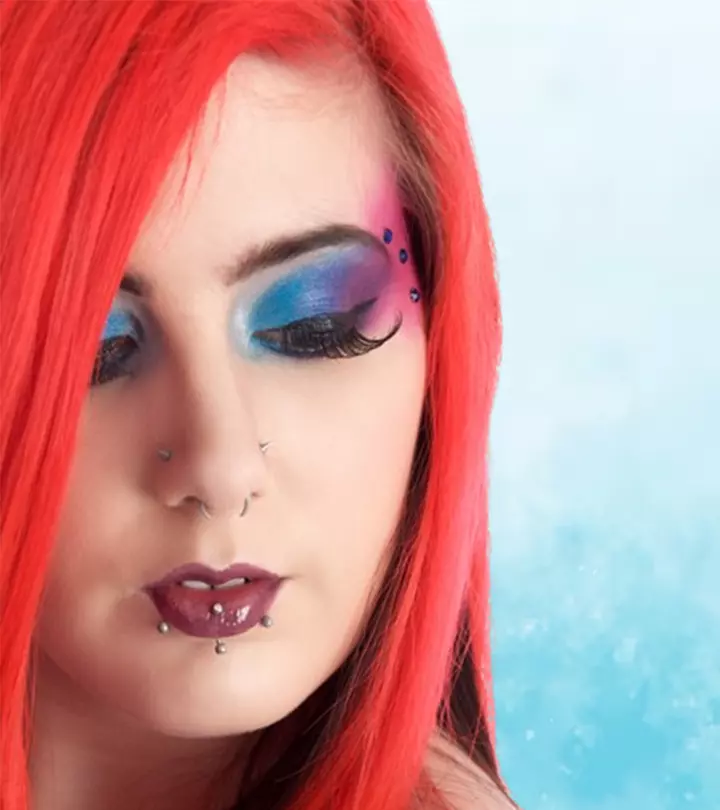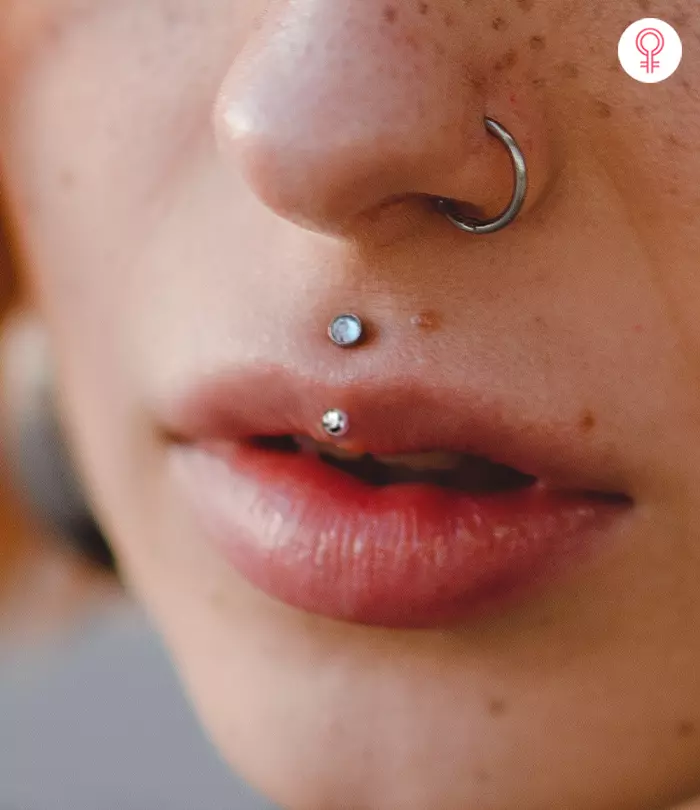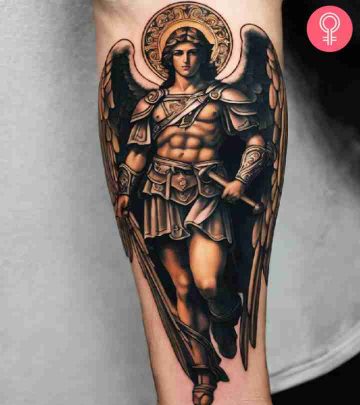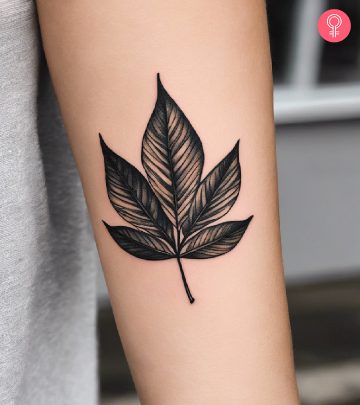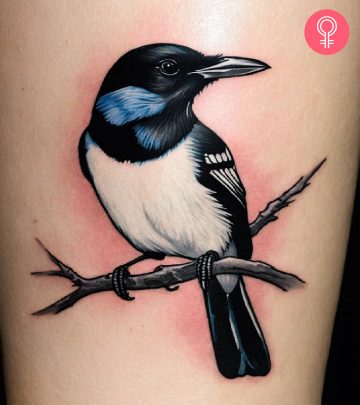Smiley Piercing: Pain, Risks, Jewelry, Healing, & Aftercare
Peek-a-boo piercings that only appear when you smile and become a conversation-starter!

Image: Shutterstock
Looking for a way to show off your quirky side? A smiley piercing is the way to go! This piercing involves inserting a piece of jewelry through the frenulum, a section of tissue connecting the upper part of the lip to the gums. And the best part? You can only see this piercing when you smile! It gives serious cool-girl vibes and appears edgy yet cute. This sweet piercing is commonly done using a hoop or a ring that hangs down. It makes for one of the wildest piercings and allows you to show off your personal style only when it suits you. It is a great way to add some embellishment to your mouth and offers numerous jewelry options. Keep reading to learn everything you need to know about smiley piercings.
 Piercing Guide: Smiley Piercing
Piercing Guide: Smiley Piercing- Placement: Frenulum, the skin tissue connecting the upper lip and gums
- Best Jewelry: Captive bead ring
- Cost: $30 to $90
- Pain Level: Low
- Healing Time: 3 to 4 weeks
In This Article
What Is A Smiley Piercing?
It is a type of body modification that involves passing a piece of jewelry through the frenulum, or the length of tissue that attaches the gum to the upper lips. This kind of piercing is hidden when your mouth is closed or relaxed, but as you smile, it commands attention, and hence the name.
The process of piercing is fairly quick and usually takes a couple of minutes to get done. For this, the professional piercer may first ask you to rinse your mouth with an antibacterial solution to ensure your mouth is clean and free of germs. Then the piercer may gently pull the frenulum to ensure accuracy and the right placement of jewelry. This process is performed using a sterile needle that passes through the sheath of skin underneath the top lip, just above the gums. Lastly, the jewelry is threaded through the hole and, if required, applicable beads are screwed in to hold it in place.
This body piercing is also popularly called a “gum piercing.” If you are considering getting one, then it is important to know that there are multiple types of smiley piercings to choose from. Check what these are to pick one that suits your aesthetic.
Types Of Smiley Piercings
There are multiple types of smiley piercings at your disposal. The type of arrangement, be it vertical or horizontal, and the very placement of the jewelry in the mouth adds to the variations and styles of smiley piercings. Here are a few listed below:
1. Standard Smiley Piercing
This is the most common of all smiley piercings. It involves piercing through the frenulum and makes for an inconspicuous piercing as the jewelry is only visible when one smiles.
2. Frowny Piercing
View this post on Instagram
This type of piercing is done on the frenulum located between the lower lips and gums. Though it is very similar to the standard smiley piercing, it is less common and is even less noticeable.
3. Double Smiley Piercing
It involves two piercings of the frenulum instead of one. This type of piercing often includes matching jewelry pieces and may appear much edgier than its counterparts. However, it requires extensive care and attention owing to the additional piercing.
4. Side Smiley Piercing
View this post on Instagram
An unconventional piercing placement, wherein the piercing is done on the side of the frenulum as opposed to the middle. This jewelry style is for those who crave a bold and asymmetrical look that is also unique.
5. Smiley Fang Piercing
View this post on Instagram
It is also commonly known as the smiley vampire piercing as these piercings appear like vampire teeth. This type of jewelry piercing features a slender yet curved barbell with pointy ends and cone-shaped knobs instead of two balls at the ends. It is quite a popular choice, especially among goths, for it lends a striking, edgy, and unique look.
If you have made your choice regarding the type of smiley piercing you would like to adopt, learn about the various types of jewelry styles associated with the same.
Types Of Jewelry For A Smiley Piercing
When it comes to smiley piercings, the jewelry involved are dainty, beautiful and versatile, such as the ones listed below:
- Captive Bead Ring
This type of jewelry is most commonly used for those getting smiley piercings for the first time. It is circular with a small opening that closes with a small bead that joins the two ends.
- Circular Barbell
This jewelry is in the shape of a horseshoe and can be embellished with natural stones or zircons. This circular, smiley piercing barbell accessory features beads on both ends to keep the jewelry securely in place.
- Simple Ring
This is a seamless ring devoid of any adornments and does not have a bead to hold it in place. It stays pretty comfortably on the skin. However, for long-term wear, you can swap it with a seamless embellished ring.
While the wrong choice of jewelry in smiley piercing can hinder the healing process, the wrong material might cause hypersensitivity issues. Hence, it is always suggested to opt for high-quality, hypoallergenic materials that do not oxidize or tarnish when in contact with air and body fluids. Check the next section for some prescribed mediums.
Materials For Smiley Piercing Jewelry
Jewelry made of materials that pose a low risk of allergic reaction are recommended for a smiley piercing. Some of these materials include titanium, stainless steel, niobium, and gold (1).
- Titanium: This metal is considered lightweight, does not contain nickel, or corrode easily, hence it is unlikely to cause any skin irritation or allergic reactions.
- Implant-Grade Stainless Steel: Surgical stainless steel is hypoallergenic and thus well-tolerated by most individuals.
- Niobium: A hypoallergenic material that is highly corrosion resistant and hence safe for piercing jewelry.
- Gold: If you are going for a gold smiley piercing, opt for 14-karat white or yellow gold to ensure a smooth healing process. Gold above 18 karat is not considered durable, while gold-pleated accessories can cause allergic reactions or infections due to unknown alloy mixes.
Once you have picked the style you want and the material in which you want your jewelry, you may naturally be wondering, how much does it all add up to, including the procedure. Read on to find out.
How Much Is A Smiley Piercing?
Anecdotal evidence suggests that a smiley piercing price can range from $30-$90 on average. Also, most often piercing studios charge separately for the pieces of jewelry, depending on the material. Moreover, piercing costs can vary depending upon the experience and reputation of the piercer, the location of the piercing studio, and piercing style and complexity. Also, if you are purchasing materials for aftercare from the same place, then it may add to the overall cost.
By enquiring about the cost beforehand, one can understand how to allocate the funds without exceeding the budget. When that is sorted, it is also smart to mentally prepare yourself for the possibility of pain. Read on to figure out if you are up to embracing the piercing.
Smiley Piercing Pain
If you are wondering if smiling piercings hurt, well, yes, they do. There is no piercing without pain! Also, every individual’s pain tolerance level is different, so that is also a strong determinant of what the experience will be like for you on the pain scale. While the frenulum may seem like a sensitive spot, the process is relatively low-pain. The smiley piercing is considered fairly tolerable because it is done in areas with fewer nerve endings, and the membrane itself is very thin. Another good part about this process is that smiley piercings are super-quick–a deep breath and thorough exhale and you will be done!
Having said that, since the size of the tissue or frenulum is quite small, it might hurt a bit more than an earlobe or lip piercing. Also, the procedure might feel extra uncomfortable, especially considering the placement. The client is expected to stay alert during the procedure as it entails frequent washing of hands, wearing gloves, and holding the upper lip for the piercer to act effectively with precision.
Since one uses their mouth constantly, be it for breathing, talking, or eating, the constant moment can cause a bit of discomfort after the procedure is done. Scroll down to understand the duration it takes for a smiley piercing to heal.
How Long Does It Take For A Smiley Piercing To Heal?
According to anecdotal evidence, it can roughly take 4-12 weeks for a smiley piercing to heal, given that there are no major complications. Also, it is considered to be relatively quicker than other oral piercing processes.
Marcia, a blogger, shared her experience of getting a smiley piercing. She writes, “Healing was a breeze, by far the easiest of all my piercings. It only took about a week.” Further, she also notes, “It was the most painless piercing I’ve ever gotten. On a scale of 1-10, I’d rate it a 2 (i)!”
However, one might experience soreness or a bit of pain after intra-oral piercing. Additionally, being that it is a thin area inside the mouth, you may have safety concerns about the process. Find out how safe the process is, in the following section.
Are Smiley Piercings Safe?
Like every type of lip piercing, there is always a possibility of infection, excessive bleeding, injury, or rejection; there is also a risk of damage to the mouth and teeth. This can happen if the smiley piercing is done incorrectly, or if the body piercing jewelry is too long, thick, or badly sized. Moreover, the wrong placement of jewelry can also cause it to rub against the gums, resulting in microtears in the area of the mouth.
It is important to understand that the smiley piercing process is not absolutely safe, and there are risks associated with the same. So, read on to be aware of the risks associated with this piercing choice.
 Pro Tip
Pro TipPotential Risks Of A Smiley Piercing
Whether you have decided to take the plunge or still are undecided about it, it is best to familiarize yourself with signs of infections, risks, and what possibly can go wrong in the smiley piercing process. This will have you better prepared before scheduling your piercing appointment. It is often seen that signs of infections are commonly confused with healing signs and irritation from the smiley piercing, and if an infection is not treated on time, it can cause health complications. Here are some side effects and signs of infection to look out for:
- Bacterial Contamination: It occurs when the bacteria is introduced to the piercing site, often due to a lack of proper aftercare, or the use of unsterilized equipment. Contamination can also be caused due to eating, drinking, kissing, smoking, and other mouth-related activities. While one may experience slight swelling or redness for a few days, if something seems abnormal, such as the piercing site blooming to twice or thrice its size, severe pain, a bad smell or pus formation, then it is probably a sign of infection (2).
- Piercing Rejection: It occurs when the body sees the smiley-piercing jewelry as a foreign object and builds skin tissues as part of the body’s natural response to push out the jewelry from the frenulum. It can lead to jewelry replacement, dislodgment, or cause the piercing site to look droopy (2).
- Swelling: Experiencing pain, swelling, and tenderness on a freshly pierced site is a fairly common side effect, often caused due to the amount of daily activity a mouth undergoes. However, if the swelling continues to persist, then it can be a cause of concern and should be addressed promptly (2).
- Teeth Damage: The lip piercing jewelry can rub against the teeth which in turn can damage your teeth and cause enamel erosion. Also, it can lead to broken and damaged teeth or cause them to shift or wear down altogether (3).
- Gum Damage: The piercing may rub against the soft gums and wear them down. If the jewelry is placed incorrectly, that is too high on the gum, it too can lead to gum recession (4).
- Speech Impediment: Initially, after the smiley piercing, your speech might sound a bit different or abnormal, owing to the piece of jewelry connected to your upper lip. You may also be constantly conscious of the piercing due to the jewelry coming in contact with your teeth as you speak. However, once you get accustomed to it, your speech pattern will return to normal.
- Accidental Swallowing: The new piece of jewelry may prove to be a choking hazard. If the jewelry is not properly secured, it might lead to accidental swallowing, which can prove to be fatal.
- Blood Borne Illnesses: If the piercing needle is not sterilized or is reused, and is somehow contaminated with infected blood, then there is an increased risk of contracting a blood-borne disease, such as hepatitis B, hepatitis C, HIV, tetanus, etc (5).
Now that you are aware of the risks, once you do get a smiley piercing, you need to care for it with utmost mindfulness. Read on to understand the basic safety precautions and aftercare steps one can take to ensure smooth healing.
Smiley Piercing Aftercare
The smiley piercing process requires following proper aftercare as the mouth is constantly in use, which makes it much more prone to infection. Given the location of the piercing, aftercare is also very crucial to keep the pierced area looking fresh and clean. However, the good part is that the aftercare for smiley piercing is not very complicated and comprises of being mindful about a few things, as listed below:
- Limit Touching: Avoid touching the jewelry as much as possible. The only time you should touch is when cleaning or removing it altogether. Excessive movement can lead to increased friction, irritation, shifting of the jewelry from its original position, or even tears and scarring.
- Use A Saline Rinse: Rinse your mouth with a saline solution twice daily to keep the smiley-pierced area clean and free from bacteria (6).
- Use Gentle Oral Care Products: Switch to soft toothbrushes and mild, alcohol-free mouthwashes, and use a toothpaste free from whitening ingredients to maintain good oral hygiene and reduce the risk of infections.
- Check Your Diet: Avoid eating hot, spicy, acidic, or crunchy foods to avoid causing trauma to the affected area and ensure smooth and successful healing. Also, rinse your mouth with water everytime after eating anything.
- Limit Alcohol Consumption: Stay away from consuming alcohol as it can slow down the process of wound healing and cause irritation to the site (7).
- Avoid Bacterial Contamination: Avoid chewing gums, biting nails or any other such activity that can introduce bacteria to the healing site.
- Avoid Kissing And Oral Sex: Intimate activities can increase the risk of introducing bacteria from the mouth to the affected area. It can also put pressure on the freshly pierced area, which in turn can lead to swelling, discomfort, or can even displace the jewelry from the area.
- Limit Unnecessary Movement: Activities that involve vigorous movement of the mouth and lips can cause trauma to the pierced area and delay healing, hence limit taking for the first few days, avoid smoking, and refrain from playing wind instruments (4).
 Pro Tip
Pro TipHow To Clean A Smiley Piercing?
- Wash your hands with soap and water before touching the smiley-pierced area.
- Prepare a saline solution (water and salt in a 2:1 ratio) and transfer to a clean bowl.
- Soak a paper towel in the solution and gently wipe the jewelry.
- Use the wipe to clean both the inside area, which is the pierced site, and the outside area of the lips.
- Repeat the process until the area is fully cleaned.
- Make sure not to scrub the area as it can lead to unnecessary friction and impede the healing process.
When And How To Change Your Smiley Piercing?
If you have decided to change your smiley piercing, it is suggested that you should at least wait for 3 months, or until the piercing is completely healed. Before changing the jewelry yourself, you can also consult the piercer about whether it is safe to remove your jewelry. Follow these steps when removing:
- Rinse your mouth with saline solution.
- Wash your hands with soap and water to remove dirt, germs, and bacteria before touching the pierced area.
- With clean hands, gently unscrew your existing jewelry.
- Swiftly yet with gentle hands and care, thread the new jewelry through the pierced hole.
- Screw the applicable beads, if any, or else close the jewelry.
- Finish off by rinsing your mouth again with the saline solution.
Smiley piercings are edgier than the traditional lip or ear piercings, and they can look really cool if done right. They are a popular choice for those who like having a secret piercing whose visibility they can control. However, since it is located inside the mouth, the area can be extra sensitive and a bit tricky to take care of. Thus, proper aftercare and being mindful of the way you use your mouth can lead to a perfectly healed piercing that you can flaunt as you wish!
Frequently Asked Questions
How old do you have to be to get a smiley piercing?
The age requirement for getting a smiley piercing can vary depending upon the policies of the piercing studios and local regulations. Most piercing studios consider the legal age for getting a smiley piercing to be 18, and people under the age of 18 need a legal guardian with them, or need to obtain written and verified parental consent.
Can you get a smiley piercing with braces?
It is suggested that one should wait until the brace is removed before going for a smiley piercing. Getting both of them simultaneously can put pressure on your teeth and gums and negatively impact your overall inner mouth.
How long do smiley piercings last?
Anecdotal evidence suggests that smiling piercings may last for a year at best. However, with proper care and attention, one can extend the longevity of the piercing to sometimes two years.
What gauge is a smiley piercing?
A smiley piercing is usually performed on a 16- or 18-gauge needle after disinfecting the mouth and following stringent sterilization procedures by the piercer.
Can you hide a smiley piercing?
Smiley piercings are easy to conceal, as they are located at the top of the inner lips and can stay hidden until you smile broadly with your teeth bared.
Key Takeaways
- Smiley piercings offer a unique look and have a quick healing time.
- It involves threading jewelry through a length of tissue connecting the gum and upper lip, which is secured using applicable beads.
- Jewelry made from titanium, gold, stainless steel, and niobium are commonly used and considered safe for smiley piercings.
- The price of a smiley piercing can vary, based on the type and material of the jewelry one selects. Other factors such as the experience of the piercer, the location of the piercing studio, etc., can also influence the overall cost.
If you are tempted to get a smiling piercing or are unsure about the pain of getting one, watch this video to educate yourself about the piercing procedure and the pros and cons of getting it done.
Personal Experience: Source
StyleCraze's articles are interwoven with authentic personal narratives that provide depth and resonance to our content. Below are the sources of the personal accounts referenced in this article.
(i) Smiley Piercing Experience, Info Etc.
https://truebeautyneverdies.wordpress.com/2013/08/30/smiley-piercing-experience-info-etc/
References
Articles on StyleCraze are backed by verified information from peer-reviewed and academic research papers, reputed organizations, research institutions, and medical associations to ensure accuracy and relevance. Read our editorial policy to learn more.
- Jewelry For Initial Piercings
https://safepiercing.org/jewelry-for-initial-piercings/ - Body piercing
https://www.ncbi.nlm.nih.gov/pmc/articles/PMC1496593/ - Oral Complications Associated with the Piercing of Oral and Perioral Tissues and the Corresponding Degree of Awareness among Public and Professionals: A Systematic Review
https://www.mdpi.com/2075-4418/13/21/3371# - Oral Piercing: A Pretty Risk—A Scoping Review of Local and Systemic Complications of This Current Widespread Fashion
https://www.ncbi.nlm.nih.gov/pmc/articles/PMC10177791/ - Needlestick
https://www.ncbi.nlm.nih.gov/books/NBK493147/ - Suggested aftercare for body piercings
https://safepiercing.org/aftercare/ - Alcohol Exposure and Mechanisms of Tissue Injury and Repair
https://www.ncbi.nlm.nih.gov/pmc/articles/PMC3117956/
Read full bio of Anastasiia Gatsko
Read full bio of Madhumati Chowdhury
Read full bio of Shreya Mukherjee








